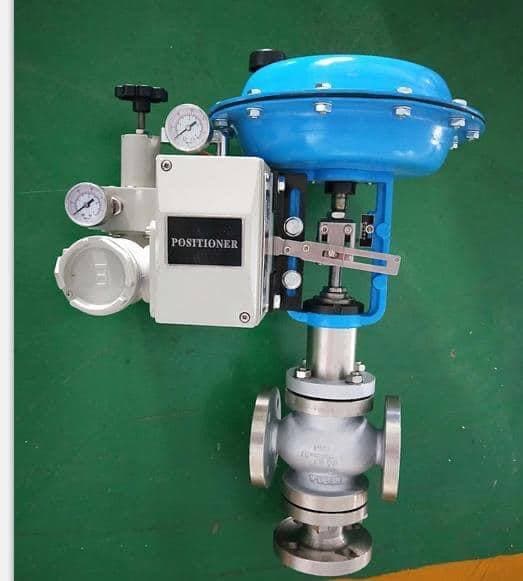Control Valve Manufacturer in USA
SVR Global is the leading and the top rated Control Valve manufacturer in USA. Control valve is operated electrically and it’s function is to control the flow of fluids through a pipeline as its name suggests. It can sustain smallest to largest capacity of fluid flow in numerous ways. This type of valve alter the spot of the plug or disc to control the flow of medium. It is controlled by an actuator. A control valve receives signal from a controller to change the flow by opening or closing the valve. The control valve manipulates the flow of medium in the form of gas, steam, water, or another suspended medium whenever there is load disturbance. Control Valve manufacturer in USA provides leak-proof, cost-effective valve delivered at your doorstep.
Control valve are used to maintain the process parameters to the optimal points as and when required. The controller set points of this valve are flow rate, pressure, and temperature. They also can sustain fluid static pressure and support seat surface and valve closure elements.
PARTS
- Valve body: The valve body is the main housing that contains the valve mechanism and connects to the process piping.
- Valve trim: The valve trim includes the internal components of the valve, such as the valve plug, seat, and stem. The valve trim is designed to control the flow rate of the fluid or gas passing through the valve.
- Actuator: The actuator is the device that provides the force necessary to move the valve plug and adjust the flow rate. There are several types of actuators, including pneumatic, electric, and hydraulic.
- Positioner: The positioner is a device that is used to accurately position the valve plug based on the control signal received from the controller. It is typically used in conjunction with an actuator to ensure accurate control of the valve.
- Controller: The controller is the device that receives input from sensors and other sources to determine the desired flow rate, and sends a control signal to the valve actuator to adjust the valve position.
TYPES
- Globe control valves: Globe valves are the most common type of control valve. They have a linear motion valve plug that is moved up and down to regulate flow. Globe valves are used in a variety of applications and can be designed for a wide range of temperatures and pressures.
- Butterfly control valves: Butterfly valves are another common type of control valve. They have a disk-shaped valve plug that rotates to regulate flow. Butterfly valves are used in applications where low pressure drop and quick shutoff are required.
- Ball control valves: Ball valves have a spherical valve plug that rotates to regulate flow. They are used in applications where high flow rates and tight shutoff are required.
- Diaphragm control valves: Diaphragm valves use a flexible diaphragm to regulate flow. They are often used in applications where the fluid being handled is viscous or contains solids.
- Single seat control valve: A single seat control valve has a single valve plug and seat. It is a common type of control valve used in industrial applications to regulate fluid flow.
- Pinch control valves: Pinch valves use a flexible tube that is pinched to regulate flow. They are often used in applications where the fluid being handled is abrasive or corrosive.
- Needle control valves: Needle valves have a long, tapered needle-shaped valve plug that is moved up and down to regulate flow. They are used in applications where precise flow control is required.
- Three-way control valves: Three-way valves have three ports and are used to divert flow between two different directions or to mix two flows together.
INDUSTRIES
- Oil & Gas Industry
- Pipeline Industry
- Marine Industry
- Power Industry
- Nuclear Industry
- Mining Industry
- Chemical Industry
- Petrochemical Industry
APPLICATIONS
- Chemical Processing: Control valves are widely used in chemical processing plants to regulate the flow of fluids and gases during chemical reactions.
- Oil and Gas Production: Control valves are used extensively in the oil and gas industry to regulate the flow of fluids, gases, and other process variables during the production and processing of oil and gas.
- Power Generation: Control valves are used in power generation plants to regulate the flow of steam and other fluids used in the generation of electricity.
- Water Treatment: Control valves are used in water treatment plants to regulate the flow of chemicals and other substances used in the treatment process.
- HVAC: Control valves are used in HVAC systems to regulate the flow of air or water, depending on the specific application.
ADVANTAGES
- Precise control: Control valves provide precise control over the flow of fluids, gases, or other process variables, ensuring that the process is operating at optimal levels.
- Energy efficiency: Control valves can be used to regulate the flow of fluids and gases to minimize energy consumption, reducing operating costs and improving efficiency.
- Safety: Control valves can be used to regulate the flow of hazardous fluids or gases, ensuring that they are handled safely and minimizing the risk of accidents.
- Reduced maintenance: Control valves can be designed to operate reliably for extended periods with minimal maintenance, reducing downtime and maintenance costs.
- Flexibility: Control valves can be customized to meet the specific needs of a process, making them suitable for a wide range of applications.
Description:
Body Materials: Ductile Iron, Cast iron (WCB, WCC, WC6) LCC, LCB, Stainless Steel (SS316, SS304), Super Duplex (F51, F53, F55)
Class: 150 to 2500, PN10 to PN450
Operations: Electro Pneumatic and Pneumatic
Size: DN15 to DN600
Ends: Flanged, butt weld, socket weld, threaded
Visit our site for more information- https://svrglobal.net/products/control-valve/





